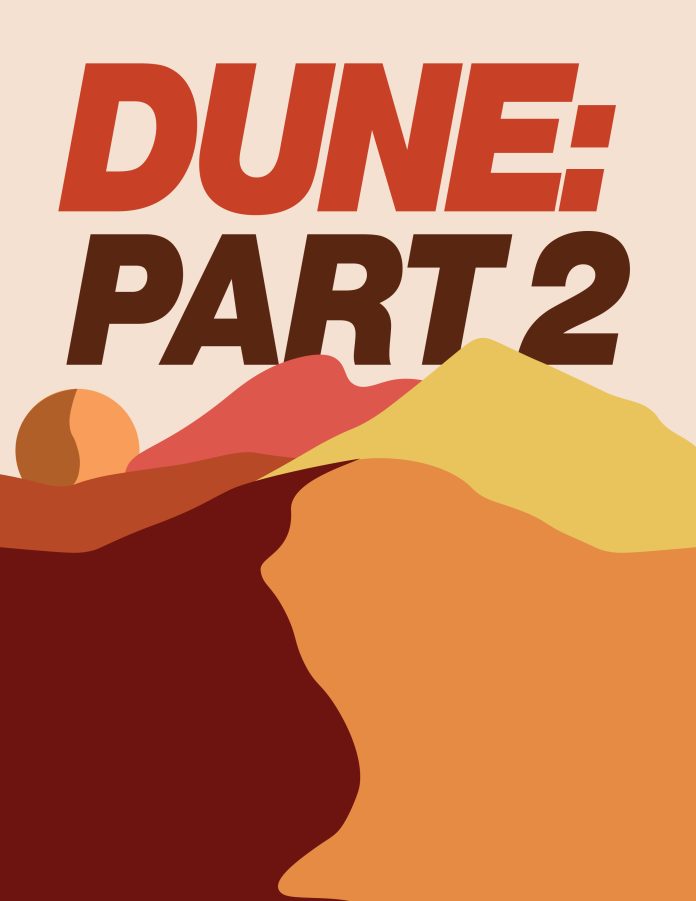I’m a big fan of Denis Villeneuve.
Hot take, I know. A guy writing a movie review is a fan of the 2010’s most prolific science fiction director? Say it ain’t so. But as basic as my taste might be, I can’t help it. Even on my tiny Macbook screen in my freshman dorm, “Dune: Part One” was a fantastic experience. “Arrival” and “Blade Runner 2049” are both excellent examples of what science fiction should strive to be as a genre, and there are multiple scenes from “Sicario” that permanently altered my brain chemistry (Glasses guy? The sunset shot? Hello?). So needless to say, I had pretty high expectations for “Dune: Part Two.” And unsurprisingly, the movie delivered in spades.
Part Two picks up almost immediately where Part One left off, following Paul Atriedes, played by Timothée Chalamet, as he struggles to find his place as a Messiah figure to the Fremen people — the native inhabitants of the film’s primary setting, planet Arrakis — while also leading them in a guerilla war against the occupying forces of House Harkonnen.
Even with my somewhat limited knowledge of the book (I skim-read it back in high school), I could feel how much Villenueve just gets it. Part One received some well intentioned criticism regarding its portrayal of subject matters such as colonialism and religion, but Part Two demonstrates that the crew completely understands exactly what Dune is about. Paul and his family are colonists, they are “white saviors.” It’s the inverse hero’s journey, the anti-”Star Wars,” and Paul’s ascent towards religious leader is enthralling and heartbreaking. From Jessica being carried in an imperial-style litter and manipulating ancient, religious rituals for her own agenda, to Gurney Halleck being giddy at the thought of using nuclear weapons, and to Paul declaring himself as the undisputed leader of the Fremen and the Duke of Arrakis; the movie is not at all subtle when it comes to its themes. Paul’s fall into villainy could not have been more clear, and yet part of me was still rooting for him because of how captivating Chalamet was.
But it isn’t just an incredible lead performance. Absolutely everyone involved gave it 110% effort from start to finish. Zendaya, Josh Brolin, Dave Bautista, Florence Pugh, everyone was great. But there were two that stood above the rest for me. Throughout the film’s release, Rebecca Ferguson’s press tour interviews were infused with this unhinged, chaotic energy, which makes her performance in the film all the more impressive. She’s cold, she’s calculating and she’s absolutely terrifying as Lady Jessica. Austin Butler is equally terrifying, but in a far more direct manner. He completely sheds the goofy Elvis demeanor fans have boxed him into, making Feyd Rautha into an appropriately horrific and unexpectedly horny character.
But what really brings the movie over the finish line for me is its presentation. I’ve always been a believer that your story isn’t what matters, but what matters is how you tell it. A good story told poorly won’t be very enjoyable, whereas a bad story told well can trick people into thinking it’s good. Thankfully for us, “Dune: Part 2” is not just a good story, but a good story told by some of the industry’s best storytellers. As per usual, Hans Zimmer creates a fantastic score, building on his work from “Dune: Part One” and infusing every scene with otherworldly instrumentation. The track “Arrival” specifically has been stuck in my head since I first heard it, and I don’t expect it to be leaving anytime soon.
The MVP award, however, must go to cinematographer Greg Fraser. I first learned his name after watching 2022’s “The Batman,” but he’s also worked on projects like “Rogue One,” “Zero Dark Thirty,” episodes of “The Mandalorian” and “Dune: Part One.” Fraser brings an unmatched sense of scale to the film, delivering more jaw-dropping shots in the first couple of minutes than most blockbusters can manage in three hours. The work is so good it cannot be genuinely conveyed by words, but the specific shot of Paul walking through the enormous crowd in the desert (you see it in one of the trailers) is especially mesmerizing.
Cinematography is a category I put some serious weight on when it comes to judging movies. Photography is my usual domain when it comes to this paper, so forgive me for getting a bit into the weeds here. When you shoot on a digital camera, the image tends to come out looking quite gray, lacking in any sort of real contrast. As of late, more and more blockbusters have developed this ugly, uniform style to them: desaturated gray images, actors who were clearly filmed against different green screens and edited together later and a general lack of care given the visuals. Three hundred million dollar blockbusters (hi, Marvel Studios) have the same filmic flair as commercials for cars or candy bars, and it’s just sad. “Dune: Part Two” breaks this pattern, and audiences have noticed: the movie has made over $450 million in global ticket sales.
It joins a recent lineup of films such as “Top Gun: Maverick,” “Avatar,” “Barbie,” “Oppenheimer” and “The Batman,” in the sense of being a blockbuster that feels like someone’s genuine vision. It’s an expensive movie that looks expensive, it has style, it has flair. The last couple of reviews from this paper haven’t been especially positive, and it’s not hard to see why. Audiences are tired of musicals that look indistinguishable from TikToks, or superhero movies that look like they were filmed in a garage. People aren’t burnt out on remakes or sequels (my list at the top of this paragraph contains a grand total of zero original ideas), we’re just tired of bad movies. “Dune: Part Two” is an uncompromising look into a director’s vision for his work, and I’m sure I’m not the only one who cannot wait for the next installment in the series: “Dune: Messiah.”

